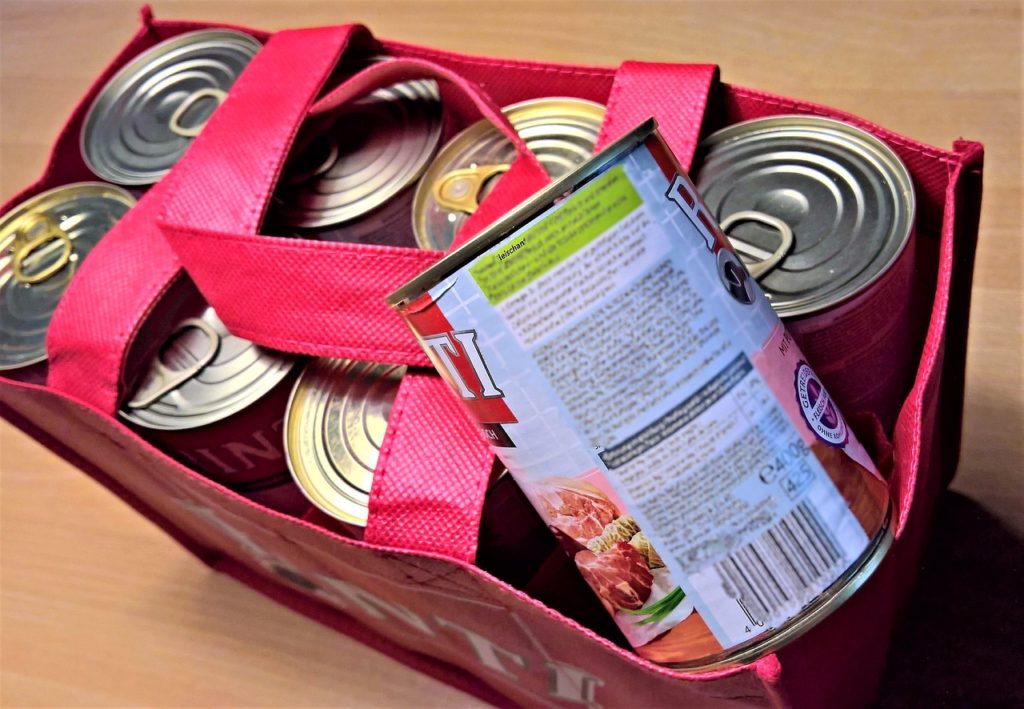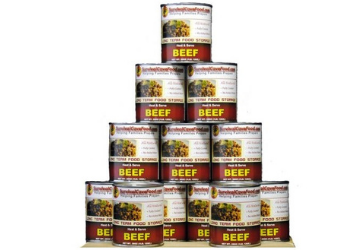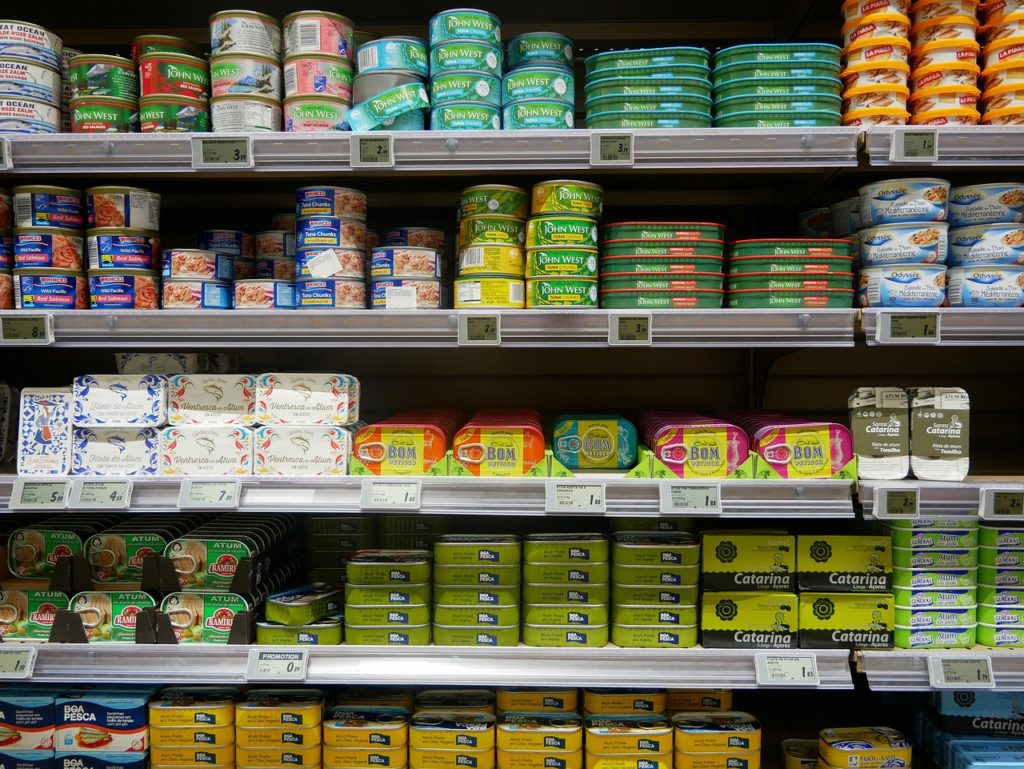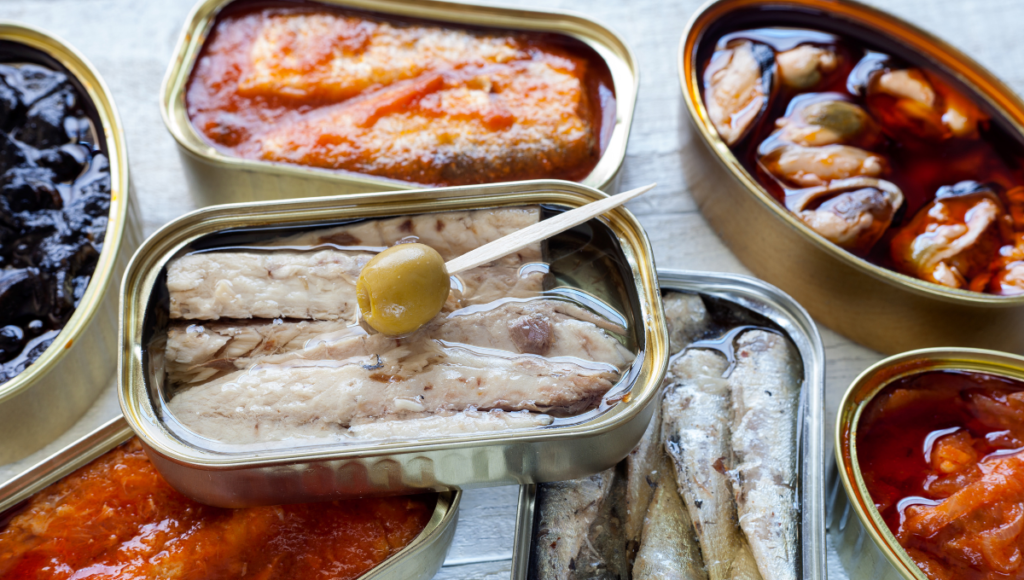Last Updated on May 16, 2023 by Lisa Vargas
In our community there is this strange idea that we are going to transform from burger eating desk job dawdlers to hunters and trappers that feast primarily on wild food.
I think if you are not currently eating lots of wild food, you killed or raised, then you will really struggle in becoming a hunter or farmer that survives off of these kinds of animals. That is the reason canned meat for survival is such an important topic.
In this article, we will dive into the subject of canned meat. Whether you realize it or not there is a wide range of canned meats to choose from and some are better than others.
Why You Should Stock Up on Canned Meat for Survival

Protein is key to any preppers pantry and it is also what most pantries are lacking. Some of us keep chickens and hunt to assure we have access to protein outside of the home. These are both great answers to the protein issue, but you can also stock your pantry with great protein options if you know what canned meat to stockpile.
Canned meat for survival does not eat, it doesn’t need to be killed and it is always in the same place. You cannot say that about other sources of meat protein. You do not want to depend on the outside world for all of your meat for this very reason.
Canned meat has a long shelf life and if you know what to buy you can add these meats to meals or even eat them straight from the can! The landscape of the canned meat market is a lot wider than you think. From things like quality canned fish to something as obscure as canned pork brains, it’s all out there!
The canning process is pretty flawless and removes air from the can that prevents bacteria from growing. This is why you can have such a great shelf life out of canned meats. Industrial canning is an incredible technology that changed the world! Why not take advantage of this in your own prepper pantry.
Keys to Look for in Quality Canned Meats

Canned meats are quite possibly one of the widest ranging canned products on the market. Perhaps soup would be the only meat product to compare. Meats are varied and really are broken down between two main categories.
Meat – These meat items are those which are still, mostly, in their original form.
Force Meat – Force meat is a category of meat that is highly processed and reformed into something either resembling meat or takes the shape of the can itself.
If we are talking about quality canned meats, you are looking for those that have been minimally processed. Things like canned salmon, canned chicken and canned mackerel are all minimally processed.
Meats that are highly processed like Spam and Vienna Sausages are tasty, but they are loaded with salt, sugar, and nitrites. While it is not a bad thing to have these on the shelf, you would not want them to be what you eat each and every meal.
Another good tell is to look at the ingredients list on the canned meats you enjoy. Canned meats with the smallest ingredient list are going to be the best.
Shelf Life of Canned Meats
To understand the shelf life of canned goods you have to know what makes them go bad. You see, canned goods are fully cooked, processed with salt and citric acid, placed in sterilized cans, and then vacuum sealed. The cans feature a lining that protect the food from direct contact with the metal.
Overtime the can takes damage from moving around and this can allow micro punctures in the can to allow air inside. Once air gets inside you are going to have bacterial growth. You could also have an acidic food that will wear out the inside lining of the can. This will create a heavy metal poisoning issue over time.

The wonderful thing about canned meats is that they are a non-acidic canned food. Unless they are canned in a tomato sauce you are safe with canned meats.
In the survival community we hear a lot about use by dates and there is much debate about how long you can keep food. Having worked in the food banking industry for 5 years, as a food safety manager, I became an expert on quality and use by dates on canned goods. You see, we had to be able to tell what was useable and what had to be discarded for safety reasons.
Our guidelines were to keep canned meats for 5 years past the best buy date! This low acidic food has no problem extending an already generous best by date by as long as 5 years. That is pretty impressive and gives you one more reason to store canned meat for survival.
Safety of Canned Meats

The canning process is incredibly safe and has a tremendous benefit. There is a reason it has been so widely accepted and we still have cans in every home in America, nearly. However, the process is not flawless and there are some things that we need to consider.
When you remove oxygen from an environment it stops the growth of bacteria. That is why this process is so effective. However, there is one bacterium, Botulinum Clostridium, that really enjoys the low oxygen environment.
The bacteria make the botulinum toxin that can be extremely dangerous to the nervous system. This bacterium likes a low sugar, low acid, low oxygen environment and thus canned meats make for a perfect home.
In the worst cases a person can experience muscle paralysis as the nervous system is affected. It is best to react to symptoms of an infection early.
Symptoms can include the following:
- double vision
- blurred vision
- drooping eyelids
- slurred speech
- difficulty swallowing
- difficulty breathing
- a thick-feeling tongue
- dry mouth
- muscle weakness
At home you can avoid botulism by practicing safe canning practices and using a pressure cooker when canning low acid foods, like canned meats. However, when you are buying already canned meats it is hard to know what has happened to that meat in its own process.
There is one telltale sign when it comes to identifying canned meats that could pose a threat from botulism: SWELLING.
When you see a swollen can where the top or sides are bulging there is some kind of bacterial growth affecting the contents of that can and you should avoid any canned meats that have this kind of bulging. You may notice this at the store or at home in your own prepper pantry. Either way, that can should be discarded.
How to Properly Store Canned Meats

A canned meat is just like any other canned food when it comes to storage. There are optimal conditions for storing canned goods and you want to be sure that all of the items in your prepper pantry are in those conditions.
You want to avoid extremes of temperature at all cost. Tin and metal alloys that are the base of these cans can expand and contract rapidly in extremes of temperature. This could compromise the seal on your canned food. Once air gets inside bacteria will begin to grow.
Store your canned goods off the ground and in an area that will not experience a lot of movement. When cans fall the damage can be minimal on the surface but, again, if your seal is compromised then you will have a better chance of opening a can and finding it spoiled.
How to Cook with Canned Meats
Cooking with canned meats is quite simple. There are two things to consider when you add canned meats to your meals.
- Canned meats are cooked all the way through. That means that you do not need to cook them for a long time. They should be added at the end of the process and just warmed through. The only exception here is if you are using canned meat to make a meatball or stuffing of some kind.
- Canned meats flake and breakup easily. When you add them to a dish you do not want to mix or stir it excessively after the meat has been added. Too much stirring and you will wind up with meat flecks in your meal rather than pieces.
Consider these two important principles when using canned meats in your cooking food.
Facts About Dehydrated Meat Products vs. Canned Meat Products
There are lots of questions when it comes to dehydrated meat products versus canned meat products. Most people are still up in the air about dehydrated foods. They just haven’t eaten them and don’t really know much about the process and its effect on food. To be honest, the process of dehydration is very gentle on meat and preserves a lot of its integrity and nutritious makeup.
Even if you have eaten many dehydrated meals you may be eating TVP or textured vegetable protein, so you need to go after freeze-dried meat to really understand the flavor and texture of dehydrated meat.
Canned meats are rapidly heated and cooled and this affects the quality of the meat. However, these meats are easier to eat and prepare. They are also cheaper and easier to stock up on because of their location at your local market.
DEHYDRATED MEAT
- It lasts longer
- It is more nutritionally sound
- It can be stored as part of other meals that are easy to store and rehydrate
- It is lighter and can be stored more effectively
CANNED MEAT
- Easier to buy
- Exponentially more affordable
- Quicker to eat
- People are simply more comfortable with it
Nutrition Facts of Canned Meats
All forms of canned meats are nutritious in some ways. However, some are better for you than others. Again, don’t forget that preference is a huge part of food storage and while canned sardines are much healthier than canned Spam, if you hate fish you are still going to be hungry!
Canned fish is probably your most healthy option and has the lowest sodium content. Salmon is going to provide you with 23 grams of protein per serving and that is impressive. Of course, fish are going to give you the most bang for your buck in terms of Omega 3s in canned form.
Canned chicken is very low in sodium, when it is not canned in salty broth, and contains a whopping 30 grams of protein in a 5oz serving. Its deep in B vitamins, Selenium and Niacin.
Canned beef is king when it comes to protein and you are going to get 88 grams in a 14.5oz serving. That is just a serious punch and why people turn to beef. You will also get some great b vitamins and a nice iron boost, as well.
Eating meat is massive uptake of nutrition no matter what type you choose. Having a variety of canned meat will give you access to easy digest protein in large amounts and the nutrients attributed to those meats.
Packaging
When it comes to canned meats you are dealing with a few different kinds of packaging. Most are canned but the canning can be a little different. You will be dealing with thick mylar for some tuna and salmon options, too.
The absolute best option is the sturdy cylindrical can. It is designed for stacking and durability. Most meats can be found in this kind of packaging and it the very best for long term storage. These types of cans can only be opened using a can opener and that is how you know the most durable of all the other options.
Some canned fish, like sardines, are packaged in the rectangular can. These are designed to be opened by hand which means they are less durable and less reliable. If they are stacked to heavily or sustain a fall the thin top could open from the damage. Worse yet, it could open a little and you wouldn’t know it.
I still store things like canned sardines and mackerel in this kind of can, but I just keep them separate and understand we have to be careful with them.
The final type of packaging is the Mylar bag that contains tuna and salmon. These are typically 4oz packages and are zip top after you eat them. This type of packaged meat is tasty and convenient but not something you would store for the long term. They are too small to feed a family and are really designed to feed one person away from home.
Stick with the traditional tin can for the bulk of your canned meat packaging.
Meat Canned in Oil or Water: Which is Better?

Canned meats can be canned in all kinds of things from sauces to mustard to spring water. Remember, if your canned meat is packed in tomato sauce or some other acidic sauce than it will cut short the shelf life of your canned meats.
However, certain meats are delicious when they are canned in oil and other meats are better just canned in water. You should also look at this choice based on how you plan to eat and use the canned meat. Are you going to eat the meat right out of the can, or will it be an ingredient in something else?
Consider this: If you are adding canned meat in oil to a soup you are going to create an oil slick on the top of your soup. That could be a problem for you. You should also consider the type of oil the meat is canned in.
Canned meat in extra virgin olive oil is a much different food than canned meat stored in soybean oil. Know your oils!
That said, one of my very favorite canned meats is a canned mackerel that is packaged in olive oil. I will bite into that any day of the week, right out of the can! So, when it comes to meat canned in oil or water much of it has to do with use and preference.
Canned Meat Survival Food
While the supermarket shelves are filled with a wide range of canned meat products there is one company that stands out as THE canned meat for survival headquarters. They are called Survival Cave Food and they do one heck of a job with canned meat.
While the supermarket features 8oz, 4oz cans and some 1lb cans of meat Survival Cave Food offers a higher quality meat in larger portions. They offer all meats in 14oz and 28oz cans!
Survival Cave Food can provide you with options in the following meat categories:
- Beef
- Chicken
- Turkey
- Pork
- Ground Beef
- Mixed
The mixed 12 can option is a great way to kickstart your canned meat stockpile. This will put 21lbs of ready to eat canned meat on your shelf!
If canned meat is a concern, do yourself a favor and look into Survival Cave Food.
Final Thoughts
You cannot substitute the nutritional value and morale boosting effects of meat in a survival situation. Like all things in preparedness you should have a tiered approach to solving the problem of meat and protein in a disaster or emergency. Canned meat for survival should play a huge roll.
Canned meat is a high quality survival food that lasts a very long time and can be purchased in a wide variety of forms. Do your best to buy quality canned meats that are minimally process but you can have some forcemeats around, too!
While food safety and product quality are essential to a good, canned meat stockpile don’t forget about preference. There is no point in storing a bunch of canned tuna if you hate it! Even though it can be cheap.
Find the meats you really like to eat from companies like Survival Cave Food and build out a stockpile that works for you and your family.
